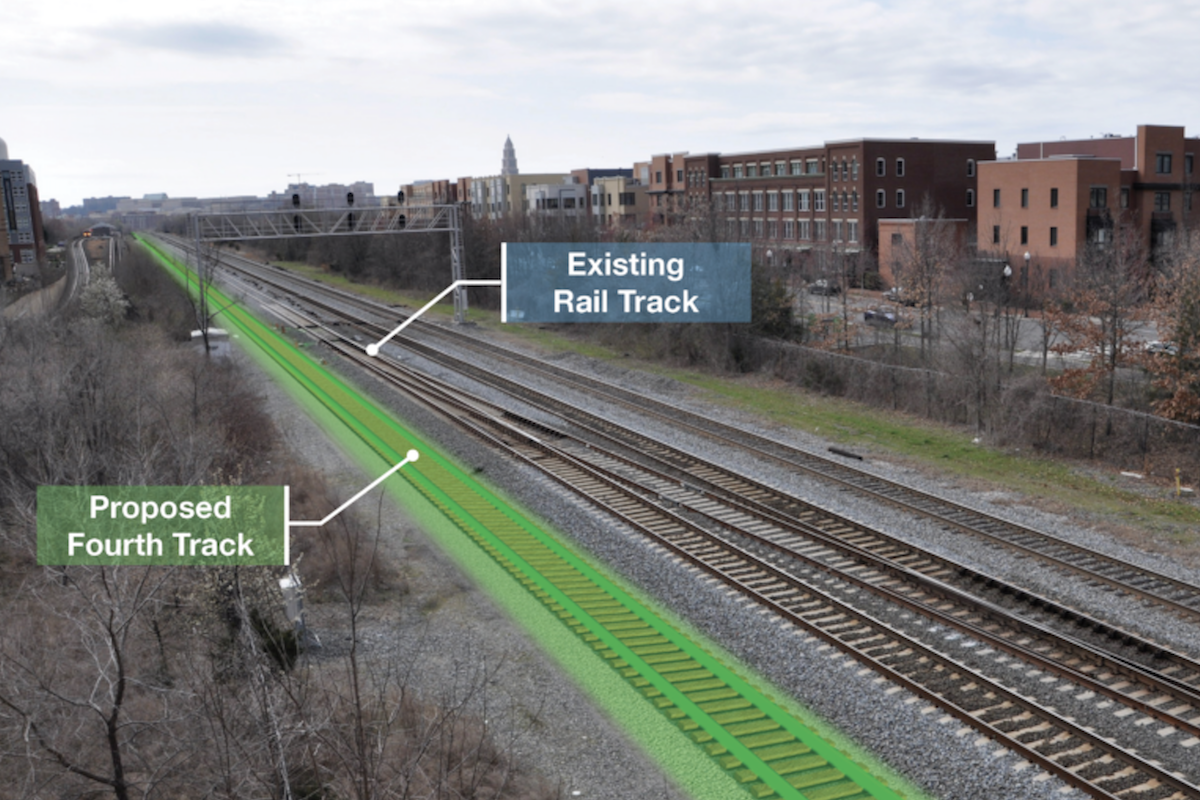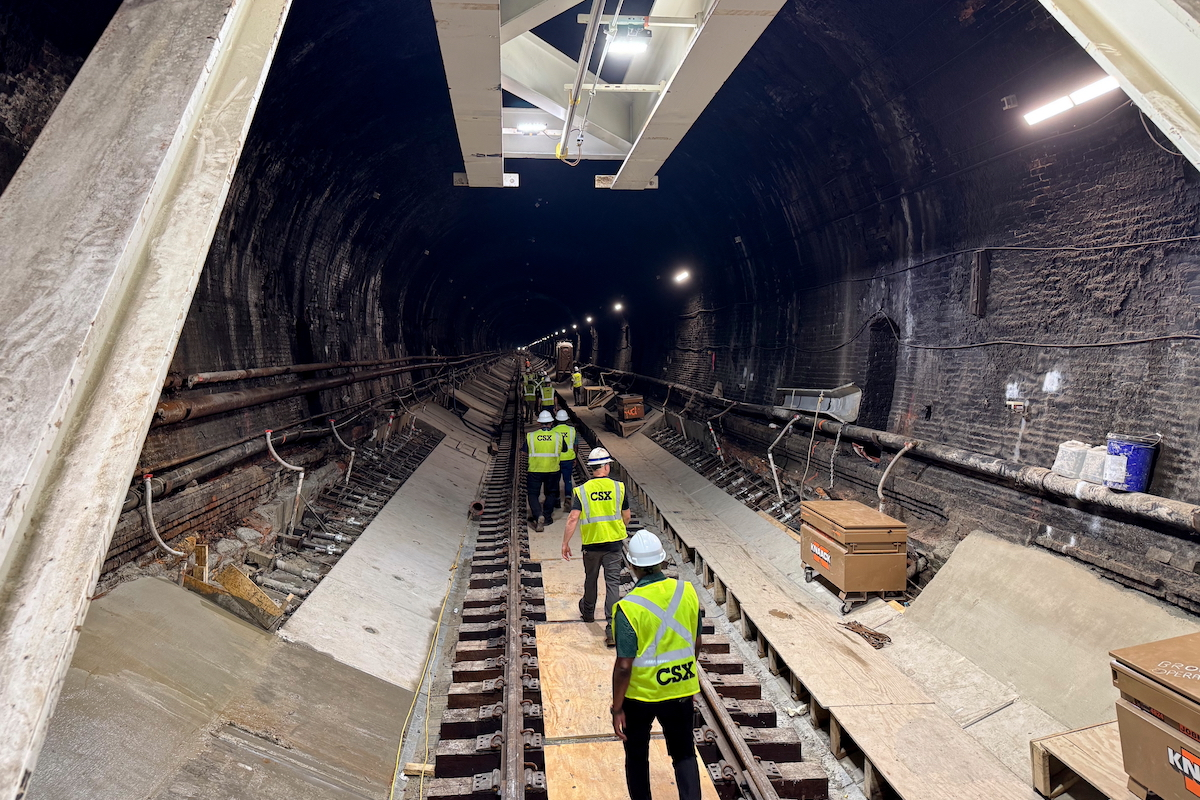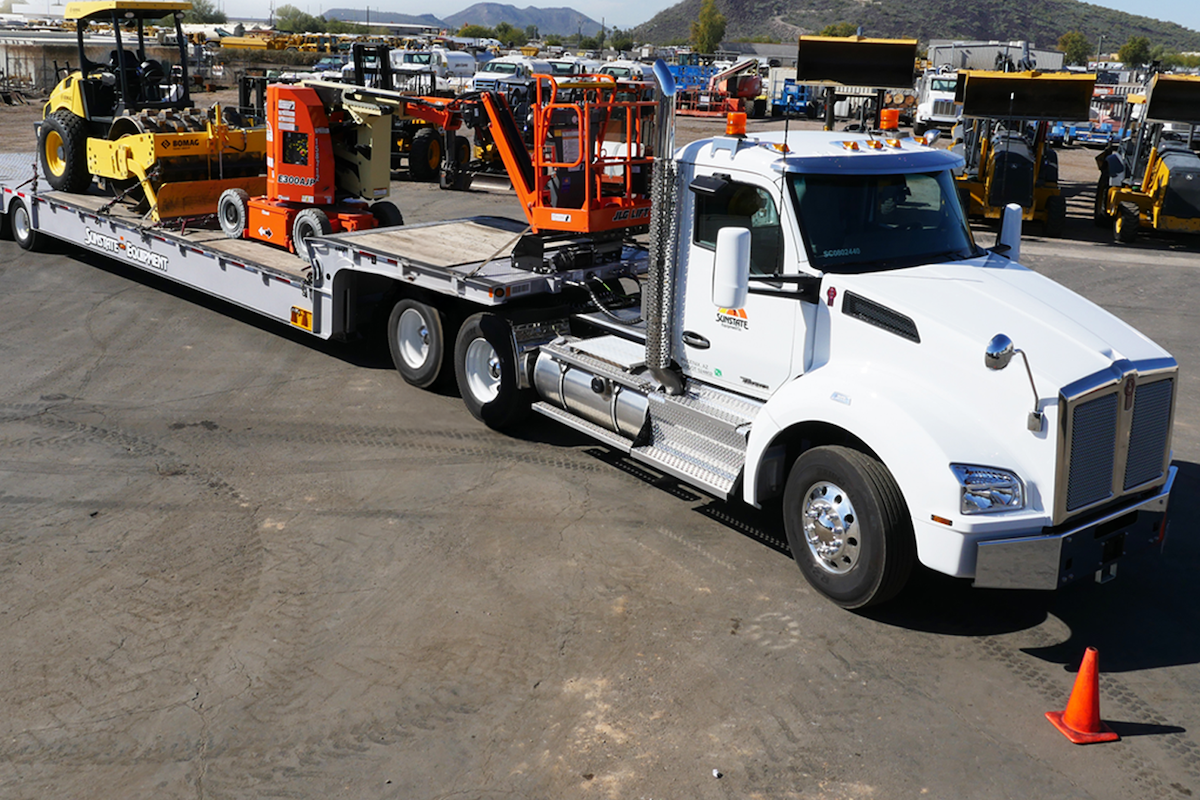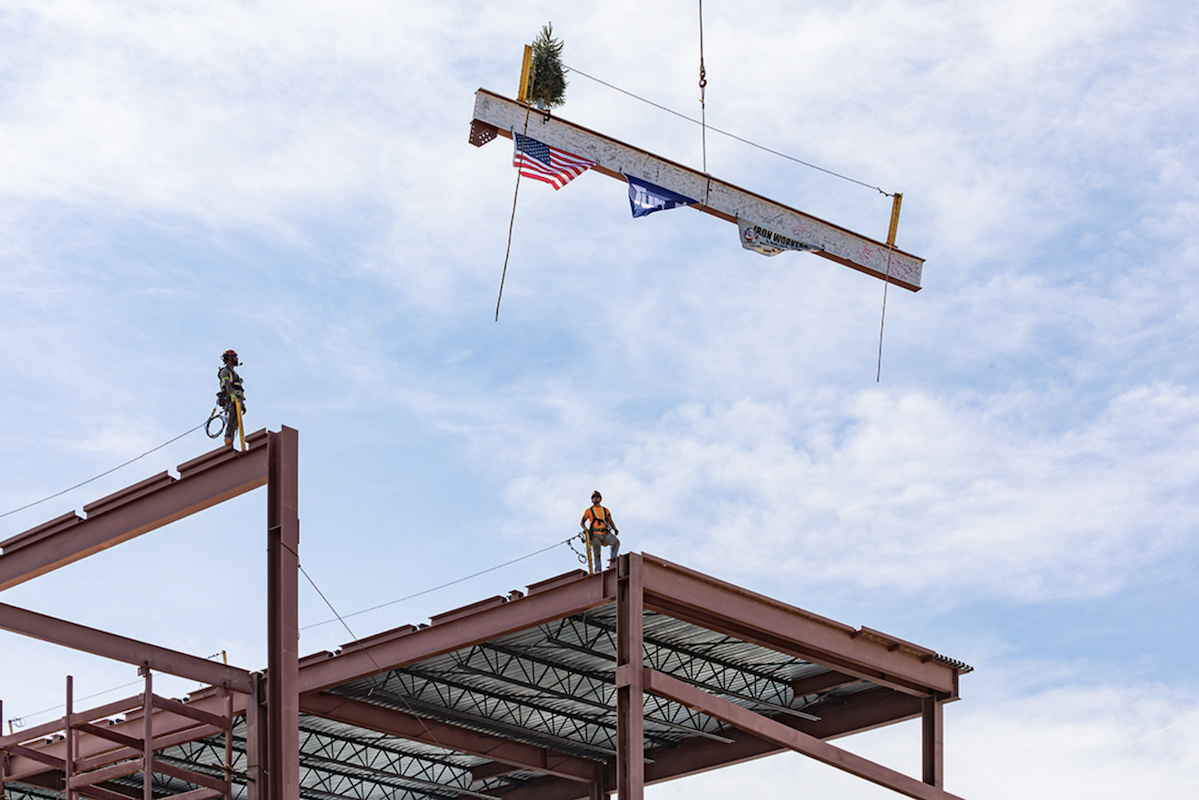Because the mass timber process uses layers of wood pressed together to create structural elements, with every penetration drilled at the factory, “There’s not one column, one beam, or one floor panel that’s interchangeable,” said Chris Johansen, C.D. Smith’s Project Manager.
The project team spent a year developing the detailed model needed by the timber manufacturers to cut the pieces. Then, with the mass timber shipped from Austria in the middle of the pandemic, they worked through layers of logistical challenges.
Once the structural elements arrived onsite, C.D. Smith only needed a 12-person crew for erection. However, managing the 3,700 unique pieces and 122,000 screws that fasten them required a complex coordination system with color coding, binders for each floor, and continuous improvement.
“Conventional wisdom at that time was that you couldn’t go tall with mass timber,” said Jodi Hogerton, New Land’s Marketing Manager. Although taller structures existed in Europe, mass timber buildings in the U.S. had stayed under 10 stories.

| Your local Komatsu America Corp dealer |
|---|
| Linder Industrial Machinery |
“We wanted something for this site that would really be differentiated from the rest of the market,” Hogerton said. “Tim took the concept design to our architect, Jason Korb (Principal Architect at Korb and Associates Architects of Milwaukee), and asked, ‘Can we do something like this?’”
Turns out, they could. About 50 percent of the wood remains exposed inside the Ascent building. With the mass timber process, a reduced environmental impact and faster construction accompanied the striking aesthetics.
Although New Land didn’t set out to build the world’s tallest mass timber structure, the 493,000-square-foot building reached 284 feet, 4 feet taller than the next-closest high-rise in Norway.
Before construction, Korb led a lengthy process to obtain variances and approval from the City of Milwaukee. That included extensive fire testing to prove the mass timber wouldn’t burn – the outside layer chars, then acts as insulation to protect the rest of the wood.
Once the city approved the project, New Land used a qualifications-based process to select C.D. Smith and Catalyst Construction of Milwaukee as general contractors in a tri-party agreement. C.D. Smith held union contracts, led the overall schedule, and self-performed the concrete and mass timber work. Catalyst handled the interior build-out.

| Your local Bomag Americas dealer |
|---|
| Linder Industrial Machinery |
The team broke ground in August 2020. Timber construction began in June 2021 and topped out six months later. In March 2022, C.D. Smith finished the enclosure. Residents moved into the first 14 floors in July 2022 and New Land opened the remainder of the building in September 2022.
In order to provide the information needed for drilling the conduit and plumbing penetrations, “We had well over a year’s worth of preconstruction meetings just around coordinating the structural and MEP service,” Korb said. “The building had to be modeled down to the millimeter digitally, then those models were fed into CNC machines as they manufactured the timber.”
Starting in April 2020, C.D. Smith performed the BIM work as they led 64 coordination meetings with Korb’s design team, Catalyst, and all the MEP trades. With the precise digital modeling, the mass timber arrived onsite ready to receive all the MEP infrastructure.
“There are about 80 penetrations on each floor, so more than 1,300 penetrations,” Johansen said. “Out of all those, we only needed to modify five onsite.”
Mass timber construction was first pioneered in Austria in the 1990s and remains more common in Europe. For this project, it cost less to import the wood from Austria than to buy it from a North American supplier. Wiehag Timber Construction manufactured Ascent’s glue-laminated timber (glulam) beams and columns and KLH Massivholz GmbH provided the cross-laminated timber (CLT) floor panels.

| Your local Topcon Positioning Systems Inc dealer |
|---|
| Linder Industrial Machinery |
Every piece included its own identification specifying the level and gridline where it should go in the structure. The biggest pieces were the CLT panels, typically 7.5 feet wide by 38 feet long, so 10 panels fit in a 40-foot Conex box. Shipped by floor, the materials began leaving Austria in March 2021.
“We originally budgeted around 20 to 25 days for shipping, but at the beginning it was actually 50 to 55 days,” Johansen said.
COVID-related issues caused delays, but so did the ship that blocked Egypt’s Suez Canal in March 2021. Even though materials for this project didn’t travel through there, when the canal reopened, backed-up container ships flooded European ports.
Because of that, “If we had eight containers for a floor, four of those got put on one ship and two on another, with two still sitting at the port,” Johansen said.
Labor shortages at U.S. ports caused many ships to divert from their original destination. Containers for Ascent landed at seven different ports in the U.S. and Canada.

| Your local Wirtgen America dealer |
|---|
| Dobbs Equipment (SC) |
“Timberlab, our mass timber supplier, was in constant communication with the manufacturers and logistics companies to determine what ship our containers were on and what port that ship was headed to,” Johansen said.
After reaching land, material traveled by train to Chicago then by semi-trailer to the Port of Milwaukee, which provided staging space and the industrial forklifts needed to pull the large structural elements out of the containers.
With their tight, urban construction site, C.D. Smith trucked material from the port to the jobsite each day. A Liebherr 316 Tower Crane, rented from Morrow Equipment Company, lifted the pieces to the working deck. Because of the timber structure, the crane couldn’t tie into the building so the operator climbed the ladder to the cab every day.
“Knowing this job would have publicity (as the world’s tallest mass timber structure) and with mass timber relatively new to this area, we met with the unions on the front end and came up with a composite crew,” Johansen said.
Each 16,000-square-foot floor typically required 64 columns and 75 beams. Two crew members rigged the material on the trailers and the remainder worked on the deck. In the beginning, the crew spent eight days per floor. They eventually reduced that to five days with very little overtime.

| Your local Volvo Construction Equipment dealer |
|---|
| Richmond Machinery & Equipment |
Although none of the crew members previously worked on mass timber, “You could almost see the gears turning in their heads as they worked," Johansen said. “Even if things were going well, they would say, ‘I think we could change this up and go a little faster.’”
“They’re not small screws; they’re 8 inches or longer,” Johansen said. “One of the main fasteners is 16 inches long by 3/8 inches thick, and we installed 1,300 of those per floor. As you install a screw that long, the thread grabs more and more material and creates more friction.”
In addition, many of the 16-inch screws needed to be installed at a 45-degree angle. “Our guys made jigs to ensure the screws laid at the right angle so they could drive them in perfectly every time,” Johansen said.
The crew used cordless Milwaukee Tool drills. “We didn’t want to use cords because they would run all over the place, and we couldn’t use impact drills because of concerns they would mess with the wood fiber,” Johansen said.
The stainless-steel screws came from Germany in two large shipments. With almost 40 types of screws, “It was a big undertaking just getting everything identified,” Johansen said. “We created binders for every floor and color-coded everything.”

| Your local Trimble Construction Division dealer |
|---|
| SITECH Mid-South |
One of C.D. Smith’s foremen served as screw manager. He looked at the drawings each day, pulled the screws needed for the next day’s work, then put them in a box that the crane lifted to the deck. The same person also managed batteries for the drills.
“The big driver I saw was starting the exterior enclosure a lot sooner,” Johansen said. “With the shoring needed for concrete, on a good project your windows are five or six floors below the working deck; on this job, we were three or four floors below. That’s a substantial time savings on getting the building enclosed and allowing interior trades to get going.”
Because mass timber weighs about one-fifth as much as concrete, it requires a smaller footprint. Cost savings also come from the smaller crew. Needing fewer workers results in less traffic, and the absence of concrete trucks and a batch plant further reduces emissions. The environment also benefits as the mass timber absorbs carbon dioxide from the atmosphere. For the crew, the work is less strenuous and dirty than conventional construction.
With the benefits and uniqueness of the new Ascent structure, the project garnered local, national, and international media coverage – including a documentary produced by a London-based company as part of the “Engineering the Future” series on Curiosity Stream.
- Developer – New Land Enterprises, Milwaukee; Tim Gokhman
- Development Partner – Wiechmann Enterprises, Milwaukee; Jim Wiechmann
- Architect – Korb and Associates Architects, Milwaukee; Jason Korb, AIA
- Structural Engineer – Thornton Tomasetti, Milwaukee; John Peronto
- General Contractors:
- Structure – C.D. Smith Construction, Milwaukee; Dave Kwiatkowski, Vice President; Chris Johansen, Project Manager; Bob Casper, Senior Superintendent; Alex Venuti, Project Engineer
- Interior – Catalyst Construction, Milwaukee; Matt Burow
- Mass Timber Procurement and Logistics – Timberlab, Portland, Ore.; Christopher Evans
- Surveying and Civil Site Design – JSD Professional Services, Milwaukee; Justin Johnson
- Fire Safety Consultant – ARUP, Washington, D.C.; David Barber
- 335,554 square feet of CLT panels
- 1,149 glulam columns
- 1,365 glulam beams
- 645,000 fasteners
- 122,000 screws
- More than 13,000 hours of timber installation







































































